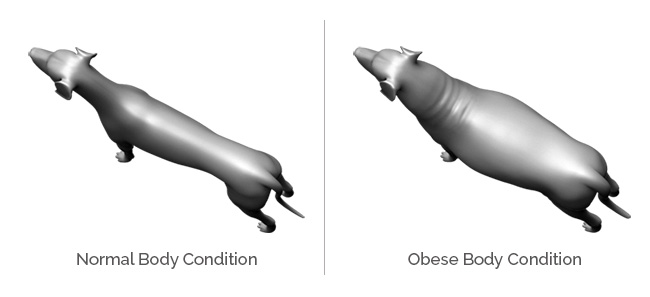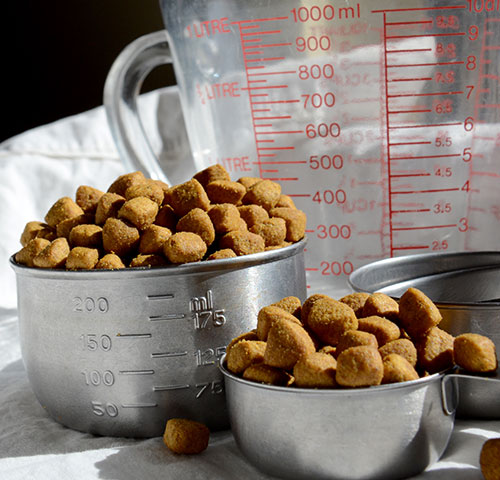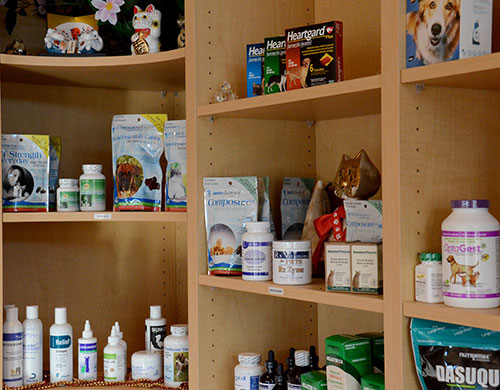Eating right and staying fit with regular exercise is not just good advice for people, it is good advice for pets too. Maintaining a healthy weight, eating high quality nutritious foods, and keeping a strong body through exercise are cornerstones to wellness throughout a lifetime.

As Americans struggle with being one of the most overweight nations in the world, our perspective of our pet’s weight is also changing. According to the Association for Pet Obesity Prevention (APOP) pet obesity rates have been rising for several years. As of 2012, 53 percent of dogs and 58 percent of cats are either overweight or obese, and 22 percent of dog owners said their pet was normal weight when their dog was actually overweight.
These extra pounds put our pets at increased risk for many of the same diseases people who encounter obesity face, including a life expectancy shortened by 2.5 years. It is not a matter of “if” a pet will contract one of the diseases listed below, it is more a matter of “when” a pet will contract the disease if he keeps the pounds on.
- Arthritis
- Cranial cruciate ligament injury
- Diabetes
- High blood pressure
- Heart and respiratory disease
- Kidney disease
- Certain Cancers – especially intra-abdominal cancers
So what can you do?
It is easier to prevent weight gain than induce weight loss. Portion control is the key from the start, as is establishing a regular exercise program. Ideally dogs should be walked at a rapid pace for at least 30 minutes a day. And cats should engage in active play for at least 20 minutes twice per day.
Our medical team has also developed a guide to diet and exercise for your cat or dog, and we have great links to pet nutrition and exercise on our resource page. Keeping your pet fit and healthy is a team effort. We will assess your pet’s current body condition and work with you to ensure your pet is receiving the right amount of quality nutrition and has an exercise program appropriate for her age, current weight, breed, lifestyle and overall health.
With so many pet foods on the market, how do you know what is best?
Should your cat eat dry or canned food? Should you feed a senior diet, or go with regular food for my older pet? Is grain free better? What about raw diets? Here are a few guidelines:
Cats are carnivores. Cats are meat eaters. Period. Meat should be one of the top 3 ingredients in any food you choose. While adding some grain or carbohydrates for fiber is ok, avoid foods with wheat, corn, or soy.
Canned food is better for Cats. Dry diets are only about 10 percent water, whereas a mouse in the wild (or a canned food diet) is 70 percent water. This extra water in cats can be vital to kidney health. And contrary to popular belief, canned food does not CAUSE dental disease in cats.
Life Stage Feeding – General Feeding Guidelines for Dogs and Cats. As pets age, their nutritional needs change, from higher requirements as puppies or active adults to lower requirements in their senior years. Here are some general guidelines.

- For Puppies and Kittens. Growing puppies and kittens need to eat frequently. Usually by six months of age they go from eating multiple times a day to eating just two times per day.
- For Adult Animals. Most foods designed for the growing needs of a puppy or kitten are too high in calories for an adult pet. The type of breed and the activity of an adult pet will help you determine the amount of food to feed.
- For Senior Animals. Most senior diets are restricted in protein since older pets with kidney problems tend to do worse on regular, higher protein diets. If your pet is still healthy, active, going on walks and playing, he may not need a senior diet. If your pet is more sedentary, a senior diet may be beneficial.
Call us with any of your life stage questions so we may help you choose the diet that is best for your dog or cat
Avoid fillers and non-essential ingredients. Dogs are omnivores and can utilize a variety of nutrients. However, foods containing high amounts of corn, wheat or soy are usually short on overall nutrition.
Avoid chemicals. Not all chemicals are bad, but in general avoid foods with things you can’t begin to pronounce. This includes ethoxyquin and nitrites, preservatives that are known carcinogens.
Raw diets. Not all raw diets are good and not all raw diets are bad. This is an area of wide controversy in pet nutrition. Some pets do fantastic with a well balance raw diet, others do not. Our staff can help you understand the pros and cons of feeding a raw diet. If you do make the choice to feed raw, please practice excellent food safety and balance the nutrients you are feeding for your pet’s age, activity and breed. Remember, feeding just raw meat is not a balanced diet.
Measure the amount you feed. Obesity is becoming an epidemic in our pets. To avoid overfeeding, measure the amount of food you put in the dish so you know exactly what your dog is eating. We can help you determine if the amount needs to be adjusted up or down based on your dog’s weight. Overweight dogs live an average of 2 years less than normal weight dogs.
Treats. Treats are critical in our relationship with our dogs. Just remember every treat adds calories, and consider this when determining how much food to feed. A “little bite” here or there can really add up, especially in a 10 pound dog.

Supplements. Just because a product says it is natural doesn’t mean it is safe. Arsenic is natural and in the right dose it will either kill or heal the patient. The FDA enforces strict legislation governing the safety, production,
and labeling of food products for the safety of the consumer. Unfortunately, this is not the case with supplements, where regulations and enforcement are minimal, particularly in supplements being sold for use in animals. To avoid harmful mistakes, consulting a licensed veterinarian who is knowledgeable about supplements and alternative medicine is still the best way to protect your pet. We are here to help you determine what will be safe and beneficial for your pet. Please don’t hesitate to ask our staff.
